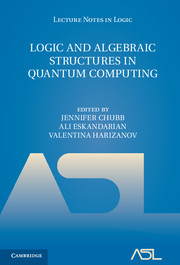Book contents
- Frontmatter
- Contents
- Preface
- Introduction
- 1 A (very) brief tour of quantum mechanics, computation, and category theory
- 2 Could logic be empirical? The Putnam-Kripke debate
- 3 The essence of quantum theory for computers
- 4 Fiber products of measures and quantum foundations
- 5 Operational theories and categorical quantum mechanics
- 6 Relating operator spaces via adjunctions
- 7 Topos-based logic for quantum systems and bi-Heyting algebras
- 8 The logic of quantum mechanics – Take II
- 9 Reasoning about meaning in natural language with compact closed categories and Frobenius algebras
- 10 Knot logic and topological quantum computing with Majorana fermions
- Index
Introduction
Published online by Cambridge University Press: 05 June 2016
- Frontmatter
- Contents
- Preface
- Introduction
- 1 A (very) brief tour of quantum mechanics, computation, and category theory
- 2 Could logic be empirical? The Putnam-Kripke debate
- 3 The essence of quantum theory for computers
- 4 Fiber products of measures and quantum foundations
- 5 Operational theories and categorical quantum mechanics
- 6 Relating operator spaces via adjunctions
- 7 Topos-based logic for quantum systems and bi-Heyting algebras
- 8 The logic of quantum mechanics – Take II
- 9 Reasoning about meaning in natural language with compact closed categories and Frobenius algebras
- 10 Knot logic and topological quantum computing with Majorana fermions
- Index
Summary
In the last two decades, the scientific community has witnessed a surge in activity, interesting results, and notable progress in our conceptual understanding of computing and information based on the laws of quantum theory. One of the significant aspects of these developments has been an integration of several fields of inquiry that not long ago appeared to be evolving, more or less, along narrow disciplinary paths without any major overlap with each other. In the resulting body of work, investigators have revealed a deeper connection among the ideas and techniques of (apparently) disparate fields. As is evident from the title of this volume, logic, mathematics, physics, computer science and information theory are intricately involved in this fascinating story. The inquisitive reader might focus, perhaps, on the marriage of the most unlikely and intriguing fields of quantum theory and logic and ask: Why quantum logic?
By many, “logic” is deemed to be panacea for faulty intuition. It is often associated with the rules of correct thinking and decision-making, but not necessarily in its most sublime role as a deep intellectual subject underlying the validity of mathematical structures and worthy of investigation and discovery in its own right. Indeed, within the realm of the classical theories of nature, one may encounter situations that defy comprehension, should one hold to the intuition developed through experiencing familiar macroscopic scenarios in our routine impressions of natural phenomena.
One such example is a statement within the special theory of relativity that the speed of light is the same in all inertial frames. It certainly defies the common intuition regarding the observation of velocities of familiar objects in relative motion. One might be tempted to dismiss it as contrary to observation. However, while analyzing natural phenomena for objects moving close to the speed of light and, therefore, unfamiliar in the range of velocities we are normally accustomed to, logical deductions based on the postulates of the special relativity theory lead to the correct predictions of experimental observations.
There exists an undeniable interconnection between the deepest theories of nature and mathematical reasoning, famously stated by Eugene Wigner as the unreasonable efficacy of mathematics in physical theories.
- Type
- Chapter
- Information
- Publisher: Cambridge University PressPrint publication year: 2016



